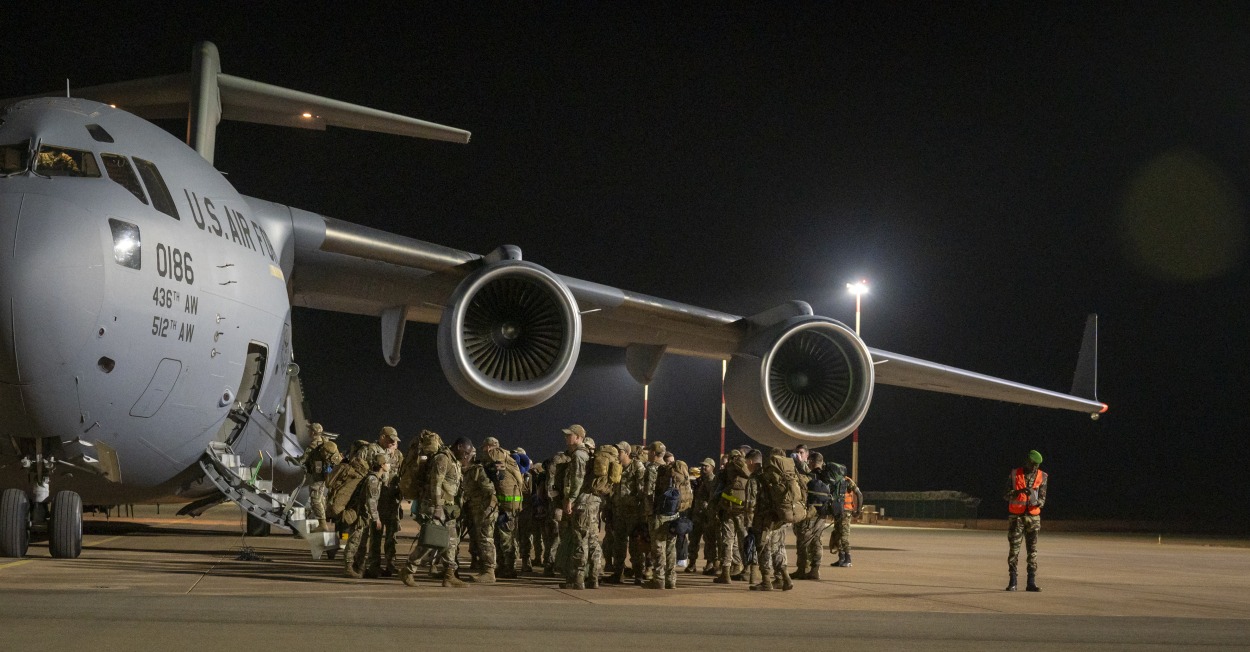The C-17 Globemaster III, an aircraft known for its versatility and capacity, has once again become emblematic of American retreat rather than resilience. On July 8, a C-17 carried the last of the US troops from Air Base 101 in Niger, a key marker of the deteriorating US influence in the region.
‘Raptor Salad’ For Lunch! US F-22 Raptor Outgunned, Outmaneuvered By German Eurofighter Typhoon?
The departure followed the decision by Niger’s junta to terminate a military cooperation agreement with the United States in March, mandating the withdrawal of nearly 1,000 American military personnel by September 15.
The process of withdrawing US troops and essential assets from Air Base 101 commenced last month, with the first C-17 Globemaster III departing in early June.
The control of the installation has since been handed back to the Nigerian government. On July 7, 2024, US and Nigerian military personnel held a ceremony to mark the end of the US military’s presence at the base.
“Today, we reflect positively on the past 15 years of security cooperation and shared sacrifice by US forces and Nigerien forces,” stated US Air Force Maj. Gen. Kenneth Ekman, US Africa Command Director of Strategy, Engagement, and Programs.

“I am grateful for the close collaboration with our Nigerien hosts to support the safe, orderly, and responsible withdrawal of US forces commemorated today at Air Base 101,” added Ekman.
For over a decade, the two US air bases in Niger have been pivotal for Washington’s counterterrorism efforts. However, with the closure of Air Base 101 in Niamey, attention now shifts to the withdrawal from Air Base 201 in central Niger.
Air Base 201 has played a critical role in intelligence operations, enabling the US to deploy drones like the Air Force MQ-9s to monitor militant groups, including al-Qaeda and ISIS affiliates.
According to Ekman, fewer than 500 personnel remain at Air Base 201, with their departure scheduled for August, ahead of the September deadline.
Some US military personnel have been moved to other countries in West Africa, and the rest will be relocated to Europe.
A joint statement from the Pentagon and the Department of National Defense of the Republic of Niger emphasized their commitment to a secure and orderly withdrawal process, ensuring the protection of American troops.
Another Setback US Hypersonic Program; As Russia, China Advance, LRHWS ‘Dark Eagle’ Delayed To 2025
C-17 Globemaster III: A Symbol Of Retreat?
The image of the C-17 Globemaster III departing from Niger is a stark reminder of the challenges and complexities of maintaining US military presence in volatile regions.
The aircraft, known for its versatility and capability to transport troops and equipment to the most remote locations, has been instrumental in various operations worldwide.
However, several events have overshadowed its distinguished history, turning it from a symbol of military excellence into one that some now see as emblematic of retreat and failure.
The most notable instance contributing to this perception was the chaotic withdrawal from Afghanistan in August 2021. The C-17 was prominently featured in images and footage that went viral worldwide, showing desperate Afghans clinging to the aircraft as it took off from Kabul’s Hamid Karzai International Airport.
The scenes were harrowing and symbolized the unorganized nature of the US withdrawal, leading to widespread criticism.
The C-17 was among the first and last US military assets to operate in Afghanistan. Its involvement in the airlift operation is still commemorated by the US Air Force.
The operation, marked by urgency, improvisation, and effective logistical management, significantly depleted the Air Force’s fleet of heavy-lift aircraft. Over 250 US Air Force mobility aircraft, including the C-17 Globemaster III, contributed to the airlift effort.
The C-17 Globemaster III boasts a distinguished record, having participated in various humanitarian missions, peacekeeping operations, and combat scenarios. Its ability to execute swift strategic airlift missions has proven essential for the US military and its allies.
It can be argued that the aircraft is simply a tool, and the circumstances surrounding its controversial use stem from broader strategic and political decisions. The C-17 remains a vital asset, capable of carrying out missions that few other aircraft can match.
Nonetheless, the repeated use of the C-17 in these high-profile retreats has led to a re-evaluation of its legacy.
The latest event adding to the C-17’s reputation occurred with the evacuation of US troops from Air Base 101 in Niamey, Niger. The C-17 was again the aircraft of choice for this mission, flying the last US troops from the Air Base out of the country.
The imagery associated with its recent missions cannot be ignored. The C-17, once celebrated for its role in delivering aid and supporting troops, is now equally recognized for its part in hasty or premature retreats.
- Contact the author at ashishmichel(at)gmail.com
- Follow EurAsian Times on Google News